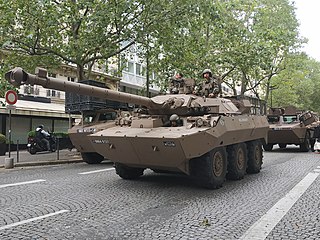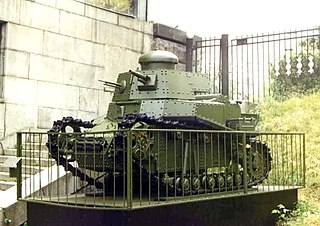
The Kliment Voroshilov (KV) tanks are a series of Soviet heavy tanks named after the Soviet defence commissar and politician Kliment Voroshilov who operated with the Red Army during World War II. The KV tanks were known for their heavy armour protection during the early stages of the war, especially during the first year of the German invasion of the Soviet Union. In certain situations, even a single KV-1 or KV-2 supported by infantry could halt German formations. The German Wehrmacht at that time rarely deployed its tanks against KVs, as their own armament was too poor to deal with the "Russischer Koloss" – "Russian Colossus".

The T-26 tank was a Soviet light tank used during many conflicts of the Interwar period and in World War II. It was a development of the British Vickers 6-Ton tank and was one of the most successful tank designs of the 1930s until its light armour became vulnerable to newer anti-tank guns. It was produced in greater numbers than any other tank of the period, with more than 11,000 units manufactured giving it the title of the most produced tank during the interwar period. During the 1930s, the USSR developed 53 variants of the T-26, including flame-throwing tanks, combat engineer vehicles, remotely controlled tanks, self-propelled guns, artillery tractors, and armoured carriers. Twenty-three of these were series-produced, others were experimental models.

The BT tank was one of a series of Soviet light tanks produced in large numbers between 1932 and 1941. They were lightly armoured, but reasonably well-armed for their time, and had the best mobility of all contemporary tanks. The BT tanks were known by the nickname Betka from the acronym, or by its diminutive Betushka. The successor of the BT tanks was the famous T-34 medium tank, introduced in 1940, which would replace all of the Soviet fast tanks, infantry tanks, and light tanks in service.

The AMX-10 RC is a French armoured fighting vehicle manufactured by Nexter Systems for armoured reconnaissance purposes. Equipping French cavalry units since 1981, over 240 remained in service with the French Army in 2021. 108 units were sold to Morocco and 12 to Qatar. "RC" stands for "Roues-Canon", meaning "wheeled gun". English language newspapers have often incorrectly referred to it as a light tank, a mistranslation of the French term "char", which refers to a wider category of armored fighting vehicles than the English word "tank".

The AMC 34 was a French tank originally built for the French Army's cavalry units. Its production was cut short, and the few vehicles produced were out of service by the time of the Battle of France in the Second World War.

The T-24 was a Soviet medium tank built in 1931. Only twenty four were built, and none saw combat. This was the first tank produced at the KhPZ factory in Kharkov, which was later responsible for the very successful BT series, T-34 and T-54 Soviet tanks. The T-24's suspension was used successfully in the Soviet Union's first purpose-built artillery tractors.

The T-44 was a medium tank first developed and produced near the end of World War II by the Soviet Union. It was the successor to the T-34, offering an improved ride and cross-country performance, along with much greater armor. Designed to be equipped with an 85 mm main gun, by the time it was fully tested the T-34 had also moved to this weapon. Both tanks offered similar performance, so introducing the T-44 was not considered as important as increasing T-34 production. Fewer than 2,000 T-44s were built, compared to about 58,000 T-34s. Although the T-44 was available by the end of the war, it was not used in any battle. It was 1 ton lighter than the T-34-85 and slightly faster. The T-44 was heavily influential on the design of the T-54/55 main battle tank, most notably the removal of side sloping, thick frontal armor, and a low profile. Also notable was the T-44-100, a 100mm D-10T-armed prototype, which would be the same 100mm gun mounted on the T-54/55, bar some minor changes.

The T-18 light tank was the first Soviet-designed tank. Produced from 1928 to 1931, it was based on the Renault FT, with the addition of a vertically sprung suspension.

The Imperial Japanese Army (IJA) initially purchased foreign tanks for evaluation during World War I, and began developing its own indigenous designs during the late 1920s.

The Type 95 heavy tank was the final result of Japanese multi-turreted tank design and was in commission during the time period between World War I and World War II. The main armament being a 70 mm cannon in a central turret, with its secondary front turret mounting a 37 mm gun and a 6.5 mm machine gun in the rear turret. Four prototypes were produced in 1934.

The Type 5 medium tank Chi-Ri was a medium tank developed by the Imperial Japanese Army in World War II. It was intended to be a heavier, more powerful version of Japan's prototype Type 4 Chi-To medium tank. Only one incomplete prototype was built.
Object 187, was a Soviet experimental main battle tank developed between the late 1980s and middle 1990s. It remains a relatively unpublicized development because of high levels of secrecy surrounding the project.
This article deals with the history and development of tanks of the Soviet Union and its successor state, the Russian Federation; from their first use after World War I, into the interwar period, during World War II, the Cold War and modern era.

This article deals with the history and development of tanks of the Japanese Army from their first use after World War I, into the interwar period, during World War II, the Cold War and modern era.

The experimental Type 98 Chi-Ho was a prototype Japanese medium tank. It was developed on orders from the Imperial Japanese Army. "Chi Ho" indicates that it is designated as the 5th medium (Chi) tank. A total of four prototypes were completed. Two were built in 1940 and two were built in 1941. It did not enter production.
The 44M Tas was a Hungarian heavy tank/medium tank design of World War II. It was developed to combat heavily armored Soviet tanks encountered on the Eastern Front and to replace the older Turán I and Turán II tanks which Hungary operated, modernising Hungary's armoured forces. The Tas somewhat resembled the German Panther tank in terms of both looks and capabilities. It was to be well armored – up to 120 mm thick and with sloped armor. The main armament would likely have been a Hungarian built heavily modified anti-tank version of the 80 mm Bofors AA gun. The only prototypes built were destroyed when the Americans bombed the Weiss Manfréd factory in July 1944.

Tanks have been employed by the military forces in Italy since their first use in World War I. They have had continued use in wars after and are still used through the modern day. The C1 Ariete is the current main battle tank of the Italian Army.

The ELC project was a prototype light tank project launched by the French Ministry of Defense in 1955. The purpose of the ELC project was to develop a lightly armoured, heavily armed fighting vehicle capable of being airlifted for rapid deployment.

The IS-2 is a Soviet heavy tank, the second of the IS tank series named after the Soviet leader Joseph Stalin. It was developed and saw combat during World War II and saw service in other Soviet allied countries after the war.















